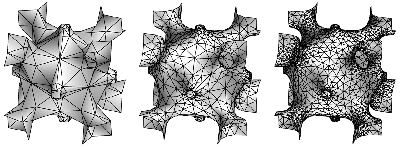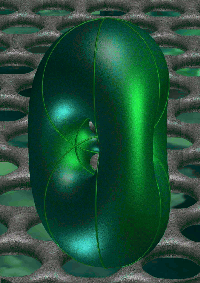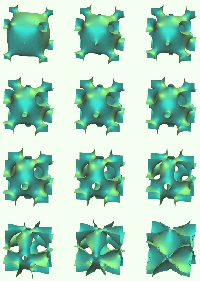
|
Sfb 288 Differential Geometry and Quantum Physics
|
 Discrete CMC Surfaces
Discrete CMC Surfaces
 A numerical algorithm
A numerical algorithm
The numerical computation of H-surfaces (H<>0) is faced with stability problems,
and standard methods were successful only in few cases. Especially, compact
H-surfaces with higher genus have not been computed.
We construct a numerical algorithm based on the definition of a discrete version
of the conjugate surface construction of Lawson which great transforms minimal
surface in S3 to H=1 surfaces in
R3. Here we define discrete harmonic maps from
surfaces in S3 to
S3, discrete minimal surfaces in
S3 (figure below left), and
a discrete conjugation algorithm. In the defininition the description of geometric
terms as discrete geometric data avoids accumulation of numerical approximation
errors.
 |
|
Discrete cmc versions of A.Schoen's O,C-TO surface with 7, 31 and 105 triangles per
fundamental patch; the complete cell in a cube consists of 48 fundamental patches.
For topological (not numerical) reasons less than 7 triangles seem to be impossible.
The algorithm solves a C1 problem for
piecewise linear numerical data, and it is an advantage of the discrete
techniques that such
coarse triangulations suffice.
|
In the conjugation algorithm we solve a Plateau problem for a discrete minimal
surface in S3 by computing a sequence of
discrete conjugate maps whose images
{Mi} converge to a discrete H-surface in R3.
The algorithm made it possible to investigate nummerically compact H-surfaces for the
first time.

|
Lawson's compact minimal surface X2,2 in
S3 (stereographically projected to
R3)
computed with discrete techniques. The symmetry lines on the surface are great
circles in S3, they divide the surface
into 18 fundamental quadrilaterals with 60 degree angles. The associated constant
mean curvature patch can be reflected to the doubly periodic surface on a hexagonal
grid which is shown in the background.
|

|
Discrete constant mean curvature companions of A. Schoen's O,C-TO minimal surface.
The surface has two free parameters, one controls the distance (which is zero for this
sequence) from the top of the handles at the centers of the cubical faces to the outer
symmetry planes, the other one controls -- after rescaling the surfaces -- the mean
curvature. At both ends of the sequence it is almost one, the O,C-TO minimal surface
with zero mean curvature would be in the middle.
|
 Author: B. Oberknapp, K. Polthier
Author: B. Oberknapp, K. Polthier
Copyright © 1999
Sfb 288,
Mathematics 8-5,
Strasse des 17 Juni 136,
TU-Berlin,
10623
Berlin


 Discrete CMC Surfaces
Discrete CMC Surfaces
 A numerical algorithm
A numerical algorithm
 Author: B. Oberknapp, K. Polthier
Author: B. Oberknapp, K. Polthier